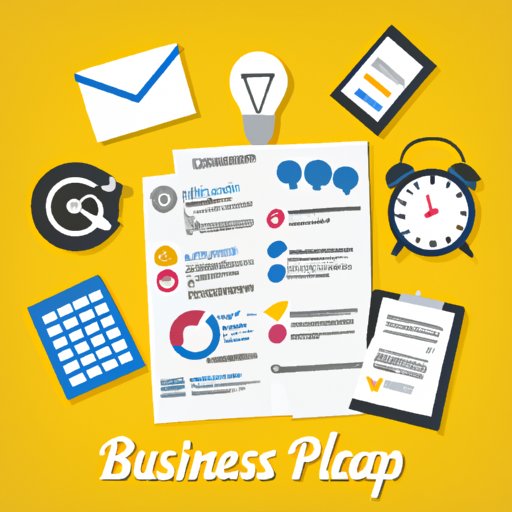
I. Introduction
When it comes to starting or growing a business, having a solid business plan is key. A business plan template is a document that outlines your company’s goals, strategies, and financial projections. It’s an essential tool for entrepreneurs seeking funding or investment, as well as for ensuring that you have a clear direction for your business.
II. 7 Steps to Writing a Killer Business Plan Template from Scratch
Follow these seven essential steps to start building a comprehensive business plan:
Step 1: Researching the market
Before you begin outlining your plan, conduct thorough market research to understand your industry, competitors, and target audience. This information will shape the direction of your business and ensure that your plan is grounded in reality.
Step 2: Defining your business goals and objectives
Establish clear, measurable goals for your company. Your business plan should articulate your vision, mission, and objectives so that you have a clear direction for your company and can measure progress over time.
Step 3: Outlining your marketing strategy
Determine how you will market your product or service to your target audience. This includes identifying your ideal customer, determining your unique value proposition, and creating a plan for reaching your target audience.
Step 4: Creating a company overview
This section of your business plan should provide an overview of your business, including your company’s history, team, and unique value proposition. It should also include a mission statement that explains why your company exists and what it hopes to achieve.
Step 5: Conducting a market analysis
This section should include a detailed analysis of your industry, competitors, and target audience. It should also include a SWOT analysis (strengths, weaknesses, opportunities, and threats) that outlines the internal and external factors that will impact your business.
Step 6: Outlining your sales strategy
Create a plan for how you will sell your product or service to your target audience. This includes identifying your sales channels, pricing strategy, and sales goals.
Step 7: Creating a financial plan
Provide a detailed financial plan that outlines your projected income, expenses, and cash flow. This section should include financial projections for the next three to five years, as well as a break-even analysis that shows how much revenue you need to generate to cover your expenses.
III. The Do’s and Don’ts of Writing a Successful Business Plan Template
When creating a business plan template, it’s important to avoid common mistakes that can undermine the effectiveness of your plan. Here are some do’s and don’ts to keep in mind:
Common mistakes that entrepreneurs make
- Focusing too much on the product or technology and not enough on the customer
- Not conducting thorough market research
- Underestimating competition or industry trends
- Not clearly articulating the business model or unique value proposition
- Overestimating revenue projections or underestimating expenses
Tips for creating a successful business plan template
- Keep it simple and easy to read
- Use data to support your claims and projections
- Be realistic and conservative in your projections
- Include a clear call-to-action or next steps for potential investors or partners
- Have a second set of eyes review your plan before sharing it with others
IV. The Anatomy of a Winning Business Plan Template
A successful business plan template should include several key sections:
- Executive Summary: A concise overview of your company
- Company Description: A detailed description of your company and its history
- Market Analysis: An analysis of your industry, competitors, and target audience
- Marketing and Sales: A plan for how you will market and sell your product or service
- Financial Plan: A projection of your income, expenses, and cash flow
To optimize each section for effectiveness, focus on providing clear, concise information that supports your overall business goals. Be sure to use data and research to support your claims and projections.
V. Creating a Business Plan Template that Works for YOU
While there are standard components of a business plan template, it’s important to customize your plan based on your unique goals, target audience, and business model. Consider the specific needs and expectations of your investors or partners and tailor your plan accordingly.
How to create a customized plan based on unique goals, target audience, and business model
- Identify your target audience and tailor your plan to their expectations and needs
- Consider the specific needs of your industry and tailor your plan accordingly
- Highlight the unique aspects of your business and what sets it apart from competitors
- Include specific details about your team, experience, and qualifications to build confidence in your ability to execute on your plan
VI. Maximizing Your Business Plan Template to Secure Funding
Creating a well-crafted business plan template can significantly increase your chances of securing funding or investment. The more persuasive and well-supported your plan is, the more likely potential investors will be to take your business seriously.
Tips for maximizing the impact of the business plan template
- Highlight key metrics, such as market size and growth potential
- Create compelling financial projections and demonstrate a path to profitability
- Illustrate your plan for scaling your business and capturing market share
- Include case studies or customer testimonials to demonstrate market traction
- Prepare answers to anticipated questions or objections from potential investors or partners
VII. Conclusion
A business plan template is a critical tool for entrepreneurs seeking to start or grow their business. Follow our 7-step process to build a solid plan that outlines your goals, strategies, and financial projections. Remember to customize your plan to fit your unique business model and target audience, and be sure to maximize its impact by highlighting key metrics, creating persuasive financial projections, and illustrating a path to profitability. With a well-crafted plan, you’ll be well on your way to achieving your business goals.





